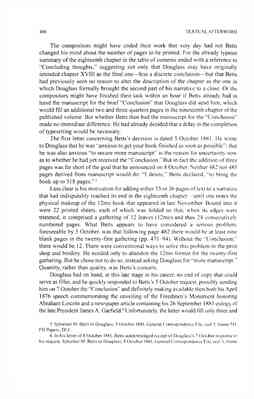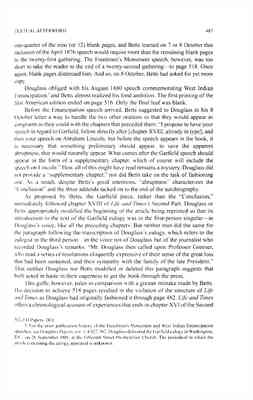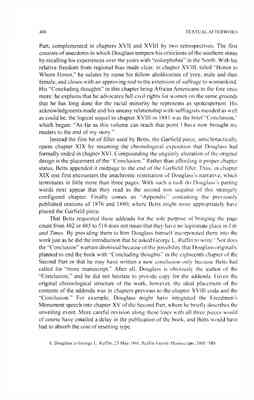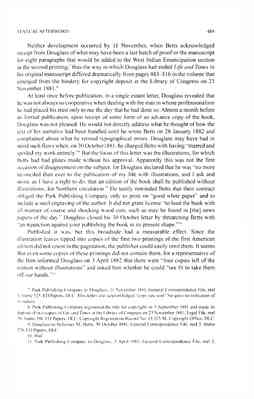Pages
1
Textual Afterword A Critical Edition of Life and Times of Frederick Douglass
JOSEPH R. MCELRATH, JR. JESSE S. CRISLER
The editors of this volume assume that the reader of Life and Times of Frederick Douglass is interested in its author's own account of his experiences and their significance in American social and cultural history—as free as possible of modifications made by others as they several times processed this autobiography for publication during his lifetime. The editors also assume that this internationally famous orator's "voice" —his word choices, phrasing, punctuation, and the like—is preferable to those of contemporaries in the publishing industry whose diction and stylistic traits displaced Douglas's in the multiple typesettings and printings recorded in the "Descriptive Bibliography" section of this volume. Accordingly, this critical edition proffers a reconstructed version of the work, the purpose of which is to make available a text that represents both the content and form for which Douglass himself was responsible as individual author.
As of Douglass's death on 20 February 1895, five major developments in the work's history of textual transmission had occurred since 1881, when he first prepared it for publication. The editors have taken into account each of these when honoring his discernible intentions as to how the work ought to read.
1. Prepublication Alterations On 7 April 1881 Douglass entered into an agreement with Thomas Belknap and Sylvester M. Betts to write a "history of his life." Their trade and subscription sales firm, the Park Publishing Company of Hartford, Connecticut, would publish it as a book of "480 to 500 pages, 12 mo, each page to contain on an average of about four hundred words."1 This was the two-part version of Life and Times: not until 1892 did Douglass compose the third. The paucity of surviving correspondence having to do with what transpired after April 1881 precludes determination of the date by which the manuscript was in Betts's hands. But it is certain that well before 8 October, Douglass had delivered one that exceeded the minimum length specified in the contract, for Betts wrote that day that the compositors had completed the typesetting through the end of what became the penultimate chapter—the eighteenth of the Second Part: "I enclose copy of the last part of the book, thus far set up, which is the conclusion of the 482d page."2
[footnote] 1. Letter of Agreement, 7 April 1881, Financial Papers File, reel 28, frame 421, FD Papers, DLC. [footnote] 2. Sylvester M. Betts to Douglass, 8 October 1881, General Correspondence File, reel 3, frame 521, FD Papers, DLC.
485
2
486 TEXTUAL AFTERWORD
The compositors might have ended their work that very day had not Betts changed his mind about the number of pages to be printed. For the already typeset summary of the eighteenth chapter in the table of contents ended with a reference to "Concluding thoughts," suggesting not only that Douglass may have originally intended chapter XVIII as the final one—less a discrete conclusion—but that Betts had previously seen no reason to alter the description of the chapter as the one in which Douglass formally brought the second part of his narrative to a close. Or the compositors might have finished their task within an hour if Betts already had in hand the manuscript for the brief "Conclusion" that Douglass did send him, which would fill an additional two and three-quarters pages in the nineteenth chapter of the published volume. But whether Betts then had the manuscript for the "Conclusion" made no immediate difference. He had already decided that a delay in the completion of typesetting would be necessary.
The first letter concerning Betts's decision is dated 5 October 1881. He wrote to Douglass that he was "anxious to get your book finished as soon as possible"; that he was also anxious "to secure more manuscript" is the reason for uncertainty now as to whether he had yet received the "Conclusion." But in fact the addition of three pages was far short of the goal that he announced on 8 October. Neither 482 nor 485 pages derived from manuscript would do: "l desire," Betts declared, "to bring the book up to 518 pages."3
Less clear is his motivation for adding either 33 or 36 pages of text to a narrative that had indisputably reached its end in the eighteenth chapter—until one notes the physical makeup of the 12mo book that appeared in late November. Bound into it were 22 printed sheets, each of which was folded so that, when its edges were trimmed, it comprised a gathering of 12 leaves (12mo) and thus 24 consecutively numbered pages. What Betts appears to have considered a serious problem, foreseeable by 5 October, was that following page 482 there would be at least nine blank pages in the twenty-first gathering (pp. 471–94). Without the "Conclusion," there would be 12. There were conventional ways to solve this problem in the print shop and bindery. He needed only to abandon the 12mo format for the twenty-first gathering. But he chose not to do so, instead asking Douglass for "more manuscript." Quantity, rather than quality, was Betts's concern.
Douglass had on hand, at this late stage in his career, no end of copy that could serve as filler, and he quickly responded to Betts's 5 October request, possibly sending him on 7 October the "Conclusion" and definitely making available then both his April 1876 speech commemorating the unveiling of the Freedmen's Monument honoring Abraham Lincoln and a newspaper article containing his 26 September 1881 eulogy of the late President James A. Garfield.4 Unfortunately, the latter would fill only three and
[footnote] 3. Sylvester M. Betts to Douglass, 5 October 1881, General Correspondence File, reel 3, frame 511, FD Papers, DLC.
[footnote] 4. In his letter of 8 October 1881, Betts acknowledged receipt of Douglass's 7 October response to his request. Sylvester M. Betts to Douglass, 8 October 1881. General Correspondence File, reef 3, frame
3
TEXTUAL AFTERWORD
487
one-quarter of the nine (or 12) blank pages, and Betts learned on 7 or 8 October that inclusion of the April 1876 speech would require more than the remaining blank pages in the twenty-first gathering. The Freedmen's Monument speech, however, was too short to take the reader to the end of a twenty-second gathering—to page 518. Once again, blank pages distressed him. And so, on 8 October, Betts had asked for yet more copy.
Douglass obliged with his August 1880 speech commemorating West Indian Emancipation,5 and Betts almost realized his fond ambition. The first printing of the first American edition ended on page 516. Only the final leaf was blank.
Before the Emancipation speech arrived, Betts suggested to Douglass in his 8 October letter a way to handle the two other orations so that they would appear as congruent as they could with the chapters that preceded them: "I propose to have your speech in regard to Garfield, follow directly after [chapter XVIII, already in type], and then your speech on Abraham Lincoln, but before the speech appears in the book, it is necessary that something preliminary should appear, to save the apparent abruptness, that would naturally appear. What comes after the Garfield speech should appear in the form of a supplementary chapter, which of course will include the speech on Lincoln." How all of this might have read remains a mystery. Douglass did not provide a "supplementary chapter," nor did Betts take on the task of fashioning one. As a result, despite Betts's good intentions, "abruptness" characterizes the "Conclusion" and the three addenda tacked on to the end of the autobiography.
As proposed by Betts, the Garfield piece, rather than the "Conclusion," immediately followed chapter XVIII of Life and Times's Second Part. Douglass or Betts appropriately modified the beginning of the article being reprinted so that its introduction to the text of the Garfield eulogy was in the first-person singular—in Douglass's voice, like all the preceding chapters. But neither man did the same for the paragraph following the transcription of Douglass's eulogy, which refers to the eulogist in the third person—in the voice not of Douglass but of the journalist who recorded Douglass's remarks: "Mr. Douglass then called upon Professor Greener, who read a series of resolutions eloquently expressive of their sense of the great loss that had been sustained, and their sympathy with the family of the late President.'' That neither Douglass nor Betts modified or deleted this paragraph suggests that both acted in haste in their eagerness to get the book through the press.
This gaffe, however, pales in comparison with a greater mistake made by Betts. His decision to achieve 518 pages resulted in the violation of the structure of Life and Times as Douglass had originally fashioned it through page 482. Life and Times offers a chronological account of experiences that ends in chapter XVI of the Second
512, FD Papers, DLC. 5. For the prior publication history of the Freedmen's Monument and West Indian Emancipation speeches, see Douglass Papers, ser 1, 4:427, 562. Douglass delivered the Garfield eulogy in Washington, D.C., on 26 September 1881, at the Fifteenth Street Presbyterian Church. The periodical in which the article containing the eulogy appeared is unknown.
4
488
TEXTUAL AFTERWORD
Part, complemented in chapters XVII and XVIII by two retrospectives. The first consists of anecdotes in which Douglass tempers his criticisms of the southern states by recalling his experiences over the years with "colorphobia" in the North. With his relative freedom from regional bias made clear, in chapter XVIII, titled "Honor to Whom Honor," he salutes by name his fellow abolitionists of yore, male and then female, and closes with an approving nod to the extension of suffrage to womankind. His "Concluding thoughts" in this chapter bring African Americans to the fore once more: he explains that he advocates full civil rights for women on the same grounds that he has long done for the racial minority he represents as spokesperson. His acknowledgments made and his uneasy relationship with suffragists mended as well as could be, the logical sequel to chapter XVIII in 1881 was the brief "Conclusion," which began: "As far as this volume can reach that point I have now brought my readers to the end of my story."
Instead the first bit of filler used by Betts, the Garfield piece, anticlimactically opens chapter XIX by resuming the chronological exposition that Douglass had formally ended in chapter XVI. Compounding the ungainly alteration of the original design is the placement of the "Conclusion." Rather than affording it proper chapter status, Betts appended it midpage to the end of the Garfield filler. Thus, in chapter XIX one first encounters the anachronic reinitiation of Douglass's narrative, which terminates in little more than three pages. With such a rush do Douglass's parting words next appear that they read as the second non sequitor of this strangely configured chapter. Finally comes an "Appendix" containing the previously published orations of 1876 and 1880, where Betts might more appropriately have placed the Garfield piece.
That Betts requested these addenda for the sole purpose of bringing the page count from 482 or 485 to 518 does not mean that they have no legitimate place in Life and Times. By providing them to him Douglass himself incorporated them into the work just as he did the introduction that he asked George L. Ruffin to write.6 Nor does the "Conclusion" warrant dismissal because of the possibility that Douglass originally planned to end the book with "Concluding thoughts" in the eighteenth chapter of the Second Part or that he may have written a new conclusion only because Betts had called for "more manuscript." After all, Douglass is obviously the author of the "Conclusion," and he did not hesitate to provide copy for the addenda. Given the original chronological structure of the work, however, the ideal placement of the contents of the addenda was in chapters previous to the chapter XVIII coda and the "Conclusion." For example, Douglass might have integrated the Freedmen's Monument speech into chapter XV of the Second Part, where he briefly describes the unveiling event. More careful revision along these lines with all three pieces would of course have entailed a delay in the publication of the book, and Betts would have had to absorb the cost of resetting type.
6. Douglass to George L. Ruffin, 23 May 1881. Ruffin Family Manuscripts, DHW-MS.
5
TEXTUAL AFTERWORD
489
Neither development occurred by 11 November, when Betts acknowledged receipt from Douglass of what may have been a last batch of proof or the manuscript for eight paragraphs that would be added to the West Indian Emancipation section in the second printing;7 thus the way in which Douglass had ended Life and Times in his original manuscript differed dramatically from pages 483–516 in the volume that emerged from the bindery for copyright deposit at the Library of Congress on 23 November 1881.8
At least once before publication, in a single extant letter, Douglass revealed that he was not always so cooperative when dealing with the man in whose professionalism he had placed his trust only to rue the day that he had done so. Almost a month before its formal publication, upon receipt of some form of an advance copy of the book, Douglass was not pleased. He would not directly address what he thought of how the text of his narrative had been handled until he wrote Betts on 28 January 1882 and complained about what he termed typographical errors. Douglass may have had in mind such flaws when, on 30 October 1881, he charged Betts with having "marred and spoiled my work entirely."9 But the focus of this letter was the illustrations, for which Betts had had plates made without his approval. Apparently this was not the first occasion of disagreement on the subject, for Douglass declared that he was "no more reconciled than ever to the publication of my life with illustrations, and I ask and insist, as I have a right to do, that an edition of the book shall be published without illustrations, for Northern circulation." He testily reminded Betts that their contract ohliged the Park Publishing Company only to print on "good white paper" and to include a steel engraving of the author. It did not grant license "to load the book with all manner of coarse and shocking wood cuts, such as may be found in [the] news papers of the day." Douglass closed his 30 October letter by threatening Betts with "an injunction against your publishing the book in its present shape."10
Published it was, but this broadside had a measurable effect. Since the illustration leaves tipped into copies of the first two printings of the first American edition did not count in the pagination, the publisher could easily omit them. It seems that even some copies of these printings did not contain them, for a representative of the firm informed Douglass on 3 April 1882 that there were "four copies left of the edition without illustrations" and asked him whether he could "see fit to take them off our hands."11
7. Park Publishing Company to Douglass, 11 November 1881, General Correspondence File, reel 3, frame 525, FD Papers, DLC. This letter also acknowledged "copy you sent" but gave no indication of its nature.
8. Park Publishing Company registered the title for copyright on 3 September 1881 and made its deposit of two copies of Life and Times at the Library of Congress on 23 November 1881; Legal File, reel 30, frame 291, FD Papers, DLC. Copyright Registration Record No. 13.325-M, Copyright Office, DLC
9. Douglass to Sylvester M. Betts, 30 October 1881. General Correspondence File, reel 3, frame 520, FD Papers, DLC.
10. Ibid.
11. Park Publishing Company to Douglass, 3 April 1882, General Correspondence File, reel 3,




